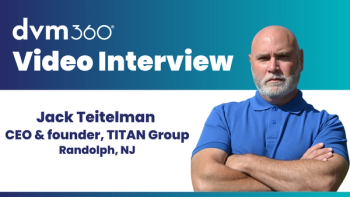
Third-party payment system makes economic, legal sense
The demands upon us continue to increase with each advance in technological sophistication.
In both the human and veterinary medical fields, there are a number of reasons to love and to hate health insurance simultaneously.
It surely would be nice if all MDs and DVMs could simply do all the work that they professionally deem necessary and expect their clients to pay for that work. Obviously, however, that's a fantasy for physicians (few people can privately afford the sophisticated diagnostic and treatment modalities of modern medicine). It's a fantasy in our profession as well: We count on private payment, but frequently do not get to do all the work that we deem necessary.
In an emergency case, the presence or absence of a third-party payer is handled differently for human and pet doctors. MDs can deny treatment to uninsured patients from the outset. They can even refuse service to those whose insurance doesn't reimburse fees to their satisfaction. Uninsured or underinsured human patients can (at least for now) default to either Medicaid or the nearby emergency room, which must, by law, treat critical cases fully.
As vets, our problem is that we often don't have any distinction between hospital and practitioner. In human medicine there is the doctor and then there is the hospital, each with its distinct responsibilities. In our field, we are the hospital and often the emergency room.
Once a case is admitted, we often are under certain legal obligations to treat the case, even if the money runs out. Additionally, we may be forced to discontinue treatment when the crisis is over because the pet owner is out of funds. This may leave the patient without necessary cruciate surgery, or without a recommended tumor excision or without whatever. There is no Medicaid for dogs and cats; there is less and less each year for us.
Imagine if there were no private insurance for people and ERs were closed to those who could not come up with a hefty deposit. There would be a lot of avoidable premature deaths and a lot fewer physicians would be driving luxury SUVs.
That's basically where many vets are today; chronically feeling guilty, often feeling worried about malpractice claims by cash-strapped pet owners and forever feeling like they ought to have a better car.
Perhaps it is time for an intelligent pet-insurance debate.
The topic is open to extensive and ongoing discussion. As an attorney, I would like to take this opportunity to share my thoughts regarding the legal impact of finding a satisfactory resolution.
The pet-insurance problem is actually fairly simple and can be explained this way:
For many, private payment for costly pet procedures is frequently out of the question. Poor people just can't afford it. People in the economic "middle" may pay for it if times are good and the pet isn't too old. For those few who are loaded with dough, the cost doesn't really matter; the work will always get done.
Increasing demands on DVMs
This system of private payment for expensive diagnostic and treatment modalities impacts the private veterinary practitioner more negatively every day. With each new declaration by some professional regulatory agency, court or state veterinary board, more is expected of us professionally. The demands upon us continue to increase with each advance in technological sophistication.
More and more, we are expected to offer and perform all of the available diagnostic and treatment services to clients, regardless of their ability or inclination to pay us. Simultaneously, the sophistication and cost of diagnostics, medicine and surgery are rising, making what is expected of us cost more each year.
Consider, for example, an HBC emergency presented to you by a regular client shortly before closing time. You explain to the client that the ideal approach would be stabilization, IV fluids, overnight intensive care, thoracic ultrasound and abdominal radiographs. Your client wants it all and it would be in your legal and economic best interest to do it all.
But the client has a very limited budget and her credit is maxed out, so the dog goes home on IV steroids, SQ fluids and a belly wrap.
When the dog dies during the night, the client considers bringing a claim before the state board and filing a lawsuit because you "knew" the dog's life depended on expensive work but you "refused" to provide it due to the client's inability to pay in a reasonable time framework.
There you are. The private-pay scenario has placed you in the position of having to reconcile the economic commitments of a private doctor with the legal obligations of a hospital emergency room. The ones caught in the middle between the demands of the owner and the government are the dog and the doggie doctor.
Pet insurance could and would change this situation by taking the economic issue out of the equation, allowing the veterinarian to discharge his legal obligation of proper care. A nice added benefit would be his ability to make some money doing what he is trained to do to the best of his ability.
Meeting a five-point test
In order to fix this perpetual problem, it is my view that a successful pet-insurance program would have to offer certain specific characteristics:
1. Financial strength. Human health insurance comes in various prices and flavors. But what I know for sure that I don't want is coverage with a company whose radio advertising concludes with the disclaimer, "not available in some states..." What this usually means is that the policy underwriter is financially weak and therefore places like California and New York, which have strict insurance departments, won't allow them to do business there.
2. Reasonable premiums. Pet insurance will work only if a large portion of the middle class can afford it and perceives it as having intrinsic value. If the concept is embraced by a large group of clients nationwide, it will become the new standard — something expected and not something exceptional. When pet coverage becomes routine, it will no longer be difficult to convince the owner of a brand-new ultra-healthy puppy or kitten that coverage should be purchased. Hence, the broad coverage base will be perpetuated.
3. Reasonable exclusions. A practical and successful pet-insurance program must exclude many pre-existing conditions. It must generally be available only to pet owners whose covered pet is under a maximum age (about 12 to 18 months.)
People will not buy pet insurance if the premium is higher than most pet surgeries. Consequently, premiums covering a large base of healthy, young pets must be counted upon to finance the claims arising for care of old, sick ones. This, of course, is why it is nearly impossible to buy nursing-home insurance when you are old.
4. Acceptance by veterinarians. Perhaps the most important issue in setting up a framework where pet insurance can be relied on to help us meet our developing legal obligations to provide top-quality care is a high level of acceptance by the veterinary community.
Currently, many of us groan when we hear that a new client has insurance because we often don't embrace the product. Insurance will not take hold in this country until practitioner acceptance is earned by one or more insurers. At the start, the only ones who are likely to be able to make pet insurance work are the service providers — us. We must believe in the benefits of the coverage enough to actually recommend it.
5. Excellent reimbursement rates and simplicity. It is incumbent upon one or more pet-insurance carriers to assemble a reimbursement schedule and a paperless, simple claim-management system. Ease of reimbursement and fair reimbursement rates are the only things that will ever make us believe in the pet-insurance concept.
Dr. Allen is president of the Associates in Veterinary Law P.C., which provides legal and consulting services to veterinarians. Call (607) 754-1510 or visit
Newsletter
From exam room tips to practice management insights, get trusted veterinary news delivered straight to your inbox—subscribe to dvm360.




